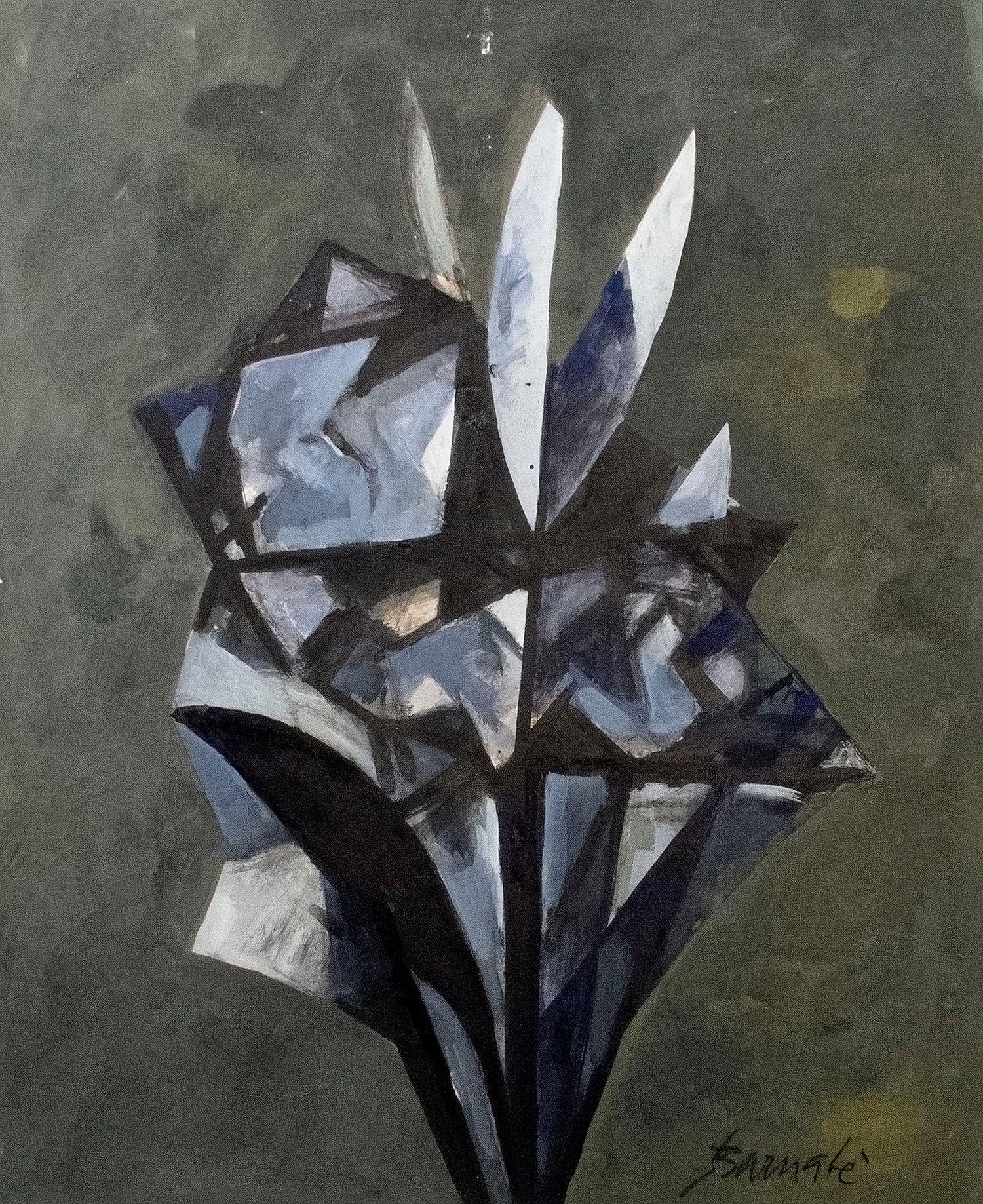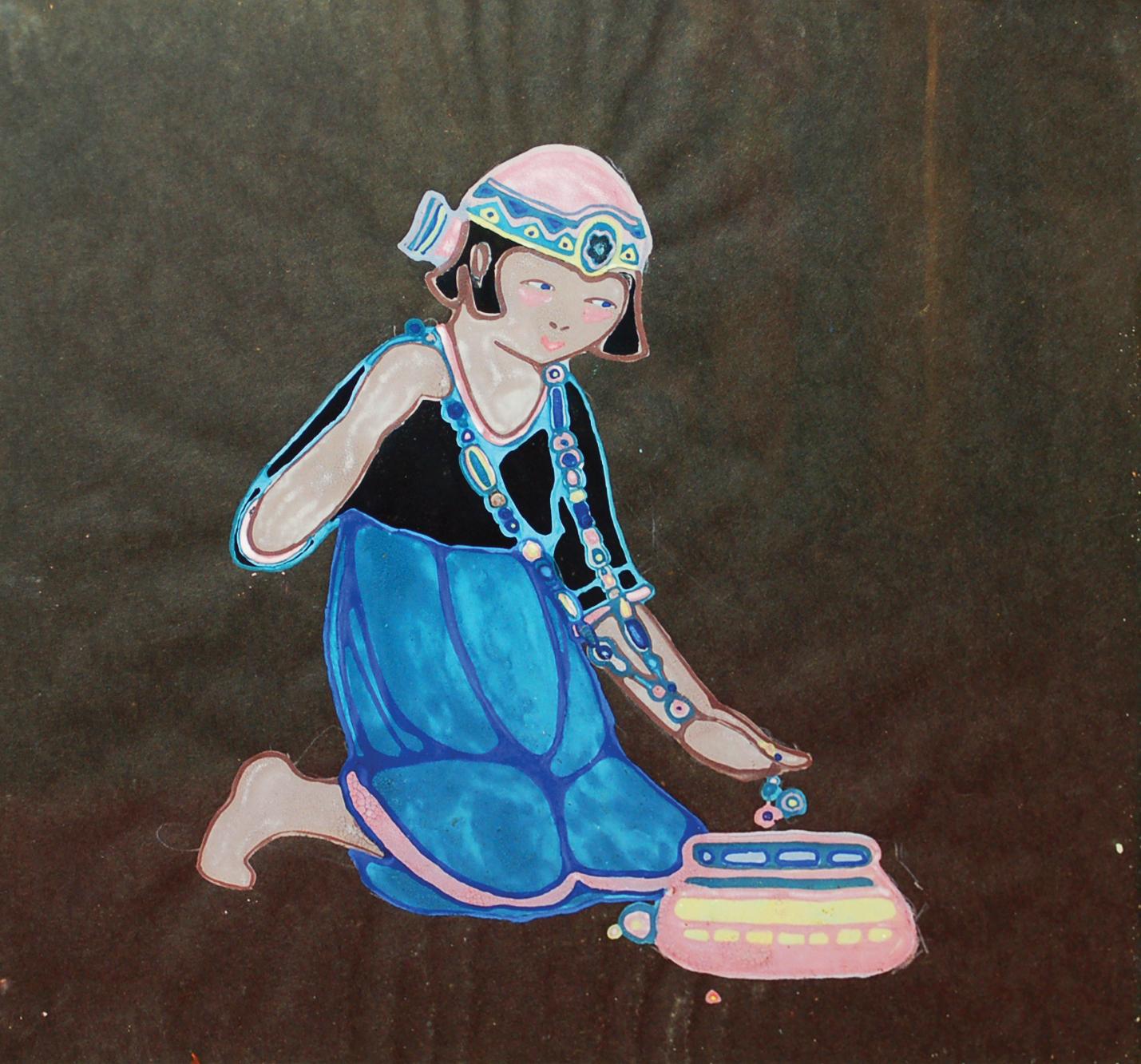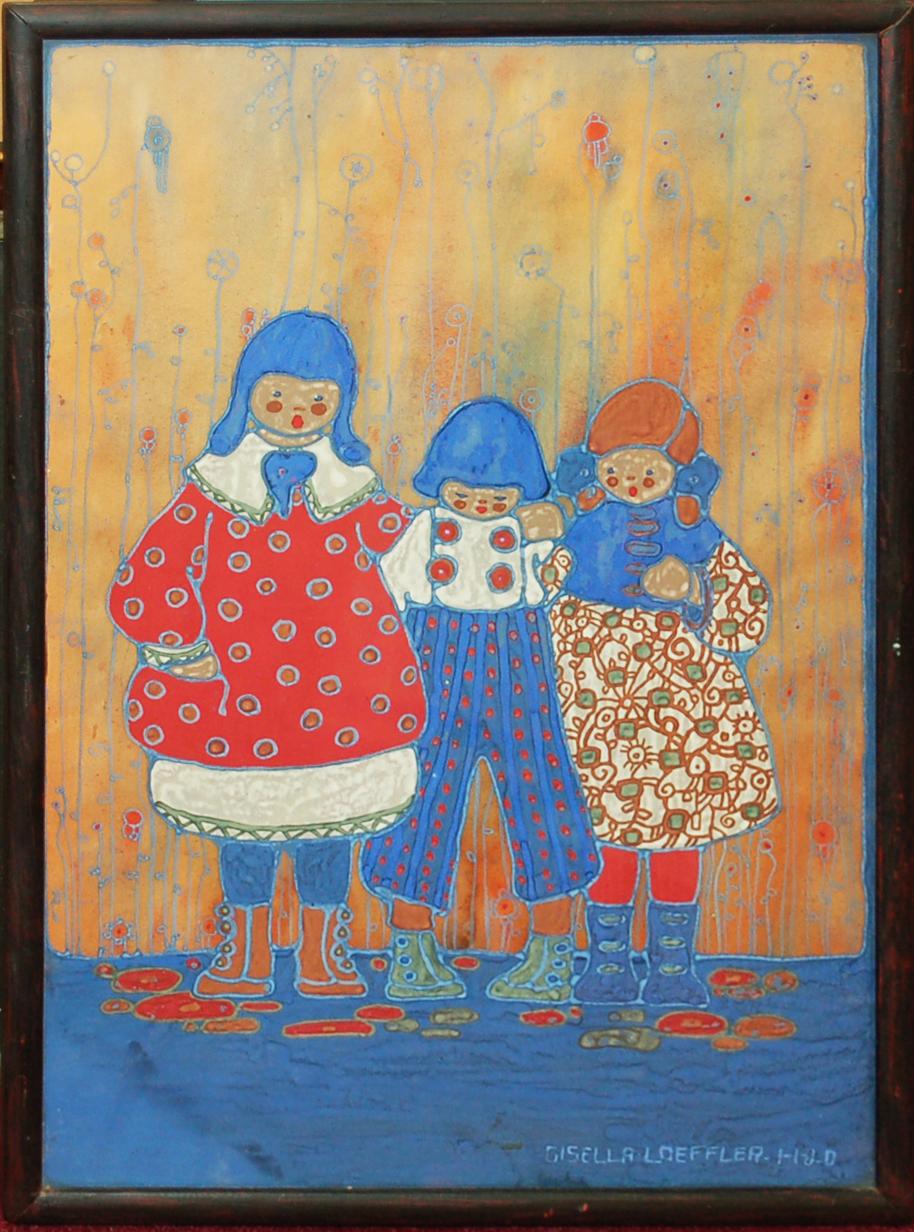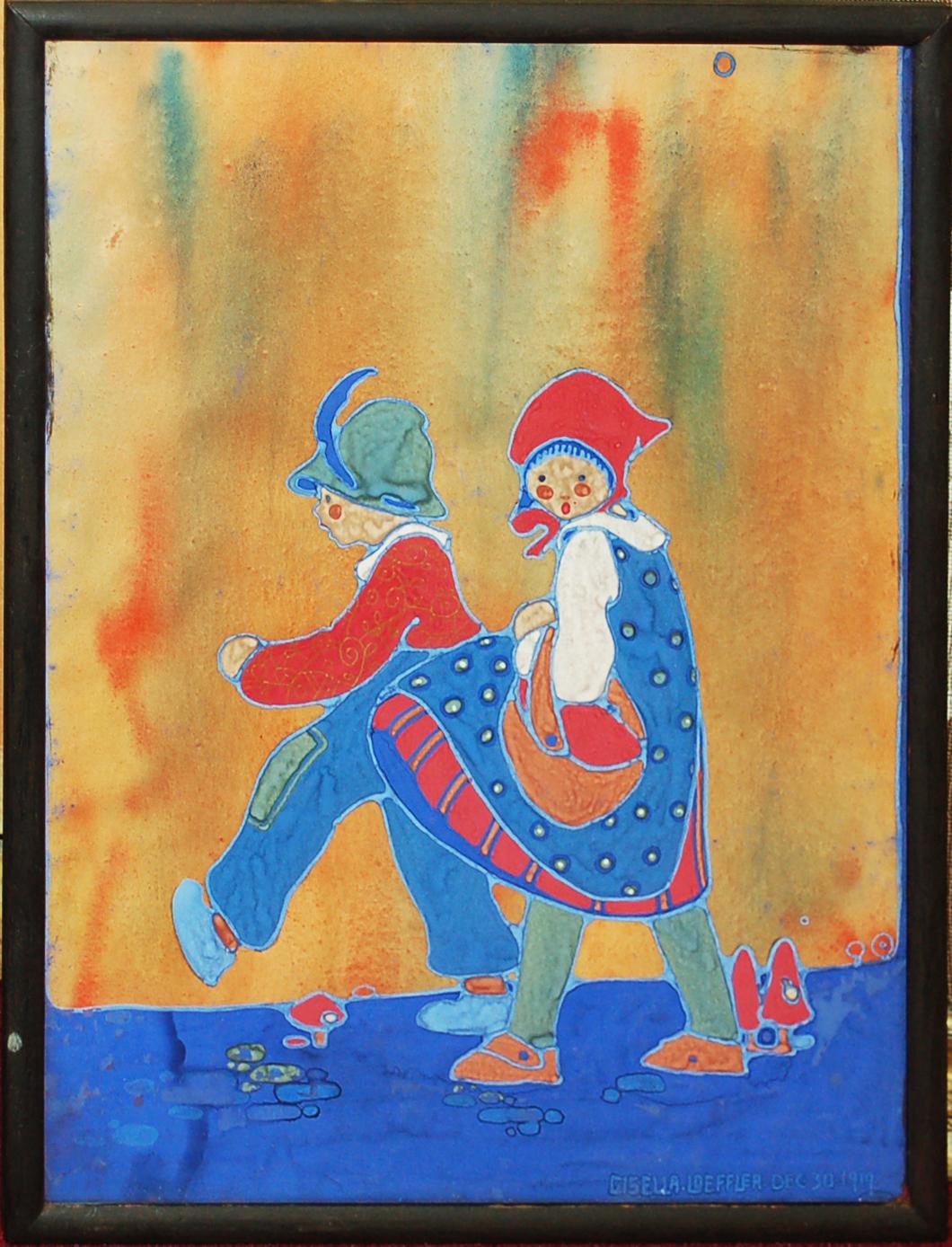Items Similar to New York Skyline
Want more images or videos?
Request additional images or videos from the seller
1 of 6
Nora Allison McGuinessNew York SkylineC. 1938
C. 1938
About the Item
The Irish landscape artist, graphic designer and illustrator Nora McGuinness was born in County Derry, Northern Ireland. She studied drawing and fine art painting at the Metropolitan School of Art, Dublin (now the National College of Art & Design), the Chelsea Polytechnic, London, and then (on the advice of Mainie Jellett and Evie Hone) under the French artist André l'Hote, in Paris.
From France, McGuiness moved to London, becoming a member of the avant-garde London Group, and from 1937-39 she lived in New York. After America, she returned to settle in Dublin in 1940. She was elected an honorary member of the Royal Hibernian Academy (RHA) in 1957 but resigned in 1969.
Nora McGuinness executed vivid, highly coloured, flattened landscape paintings, (as well as still-life and portrait art) in a spontaneous style influenced in part by the colourist Fauvist movement and the artist Lhote. Although her painting remained figurative, her work reveals the Cubist influence of Lhote, and she was associated with the modern movement in Ireland. A founder member of the Irish Exhibition of Living Art (she succeeded Mainie Jellet as President in 1944), McGuiness (like Maurice MacGonigal) first showed at the RHA in 1924 and became an honorary member (HRHA) in 1957. She exhibited her paintings and designs in Ireland at the Victor Waddington Galleries and The Dawson Gallery, Dublin, and in London at the Wertheim Gallery. Together with Nano Reid, she represented Ireland in the 1950 Venice Biennale.
In addition to paintings, Nora McGuinness executed a large number of book illustrations, theatre sets and costume designs during her career. She also designed the sales windows of Altman's in New York and Brown Thomas, Grafton Street for over thirty years. In 1968, a retrospective for Nora McGuinness artworks, numbering over 100, was staged by the Douglas Hyde Gallery, Trinity College Dublin. Another retrospective took place at the Frederick Gallery, Dublin, in 1996.
Her work appears in all the major Irish public collections - including: Hugh Lane Art Gallery, Dublin; Arts Council of Ireland; Arts Council of Northern Ireland; Ulster Museum, Belfast; Crawford Art Gallery, Cork; Irish Museum of Modern Art (IMMA), Dublin; National Gallery of Ireland, Dublin; University College Dublin; Waterford Art Gallery Collection; The Victoria and Albert Museum London; Meath County Council - as well as in several important overseas collections such as the Joseph H. Hirschorn collection in New York.
Framed Size: 30 x 25.5 inches
- Creator:Nora Allison McGuiness (1901 - 1980, Irish)
- Creation Year:C. 1938
- Dimensions:Height: 19.25 in (48.9 cm)Width: 14.5 in (36.83 cm)
- More Editions & Sizes:19.25 x 14.5Price: $5,500
- Medium:
- Movement & Style:
- Period:
- Condition:Very good condition, not examined out of frame.
- Gallery Location:Los Angeles, CA
- Reference Number:1stDibs: LU3914423542
About the Seller
5.0
Vetted Seller
These experienced sellers undergo a comprehensive evaluation by our team of in-house experts.
Established in 1972
1stDibs seller since 2011
384 sales on 1stDibs
Typical response time: <1 hour
- ShippingRetrieving quote...Ships From: Edgewater, NJ
- Return PolicyThis item cannot be returned.
More From This SellerView All
- Still Life on WindowsillLocated in Los Angeles, CAJamison's work has been widely exhibited in museums and galleries,[6][7] including the Metropolitan Museum of Art, and are included in the permanent collections of the Pennsylvania A...Category
1970s Naturalistic Mixed Media
MaterialsWatercolor, Gouache
- Rockport, MassachusettsBy Gifford BealLocated in Los Angeles, CAGifford Beal, painter, etcher, muralist, and teacher, was born in New York City in 1879. The son of landscape painter William Reynolds Beal, Gifford Beal began studying at William M...Category
1940s Post-Impressionist Mixed Media
MaterialsWatercolor, Gouache, Graphite
- Beach at MalcesineBy Nell BlaineLocated in Los Angeles, CANell Blaine, painter of still lifes and landscapes in brilliant colors, created abstract work that gives the appearance of being done in a carefree, totally lighthearted manner but i...Category
1980s American Modern Mixed Media
MaterialsPastel, Watercolor
- Junction of Woodland and Esopus CreekBy Reynolds BealLocated in Los Angeles, CABorn in New York City, Reynolds Beal's year of birth is reported as being 1866 as well as 1867. If one follows the most extensively researched source produced in consultation with t...Category
1910s Post-Impressionist Landscape Drawings and Watercolors
MaterialsWatercolor
- TreesBy Pavel TchelitchewLocated in Los Angeles, CAProvenance: William M. Chambers Fine Art Acquired directly from the owner by previous owner See info verso A Russian-born painter and stage designer, Pavel Tchelitchew worked in man...Category
1940s Abstract Impressionist Landscape Drawings and Watercolors
MaterialsWatercolor
- Au BarBy Philippe Henri NoyerLocated in Los Angeles, CAPHILIPPE NOYER "AU BAR" WATERCOLOR, SIGNED FRANCE, C.1960S 25.5 X 19.5 INCHES Philippe Henri Noyer 1917-1985 Philippe Henri Noyer was born on June 28, 1917 in Lyons, France. After a traditional education at the elite Ecole des Roches, Noyer enrolled in the Ecole des Beaux Arts in Lyon. Next he moved to Paris, where he worked in decorative arts and advertising. It was during this time, he discovered his talent for oil painting, officially starting his painting career in 1943. That same year, Noyer met the famed Parisian art deal, Emmanuel David, who would promote his work and career. Noyer produced many portraits, for which he quickly gained an international reputation, but he also painted dream figures in rural or maritime settings, compositions that were classical in technique but surreal in concept. In 1947, Noyer held his first one-man show at the prestigious Drouant-David Gallery in Paris. In 1949 the gallery consigned twenty of Noyer’s paintings to an American art dealer who had agreed to organize an exhibition of them in the United States. However the American dealer sold the paintings at cost, in order cover a gambling debt, to Robert Goldstein...Category
1960s Art Deco Figurative Paintings
MaterialsWatercolor
You May Also Like
- Mazzo di fiori (Bouquet)By Duilio BarnabeLocated in Chicago, ILThis charcoal and gouache still-life is signed by Barnabè in the lower right. In 1959, French art critic Michel Concil-Lacoste, in the newspaper Le Monde, expressed his views on Bar...Category
1950s Modern Still-life Drawings and Watercolors
MaterialsCharcoal, Gouache
- The Necklace and the PotBy Gisella LoefflerLocated in Missouri, MOGisella Loeffler "The Necklace and the Pot" c. 1919 Gouache on Paper Initialed Lower Left Framed Size: approx 15 x 15 inches In a village filled with colorful characters, few Taos artists were as colorful as Gisella Loeffler [1900-1977]. From her handmade Austrian clothing and hand-painted furniture to whimsical paintings and letters written in multicolored crayon, joyful color defined the artist, who early on chose to use simply Gisella as her professional name and was known as such to everyone in Taos. In spite of her fame there—the Taos News once labeled her a Taos legend—Gisella is rarely included in scholarly discussions of the Taos Art Colony. This oversight is likely due to the naive quality of her work, in which children or childlike adults inhabit a simple, brightly colored world filled with happiness. The macabre, the sad, the tortured, the offensive—all have no place in Gisella’s paintings. Her naive style of work looks very different from that of the better-known early Taos artists. Yet both Gisella’s artwork and her interesting life command attention. Born in Austria, Gisella came to the United States with her family in 1908, settling in St. Louis, MO. After studying art at Washington University in St. Louis, she became a prominent member of the local art community, joining the St. Louis Art Guild as well as the Boston Society of Arts and Crafts. In addition to creating posters for the St. Louis Post Dispatch, Gisella won prizes from the Artists Guild of the Author’s League of America in 1919 and 1920 and from the Kansas City Art Institute in 1923. She also began working in textiles, including batik, to which she would return later in her career. In the early 1920s Gisella married writer and music critic Edgar Lacher. A difficult character, Lacher may have chafed under Gisella’s success, for the couple divorced in the 1930s. Having seen a local exhibition of paintings by Taos artists Oscar Berninghaus (who was from St. Louis) and Ernest Blumenschein, Gisella felt drawn to Taos, which reminded her of the villages of her native Austria. In 1933 the single mother with two daughters, Undine and Aithra, moved to Taos, where she lived off and on for the rest of her life. She traveled frequently, spending extended periods in Mexico, South America, and California, but always returned to New Mexico. Gisella initially applied an Austro-Hungarian folk-art style to the Indian and Hispanic subjects that she found in New Mexico. In her early work she covered her surfaces with decorative floral and faunal motifs, and her images were flat with no attempt at rendering traditional one-point perspective. Eventually, though, Gisella developed her own style, often using children or childlike figures as subjects. Still, the influence of her native country’s folk art remained evident in her New Mexican, Mexican, and South American images. In 1938 Gisella moved briefly to Los Griegos, north of Albuquerque, to be closer to medical facilities for her eldest daughter, who was suffering from rheumatic fever. Two years later, she moved to California to participate in the war effort, painting camouflage and decals on airplanes for Lockheed. In California, Gisella broadened her range of artistic pursuits. She taught art privately, created illustrations for Scripts Magazine, and did interior design for private homes. She also designed greeting cards, a practice she continued after her return to New Mexico, where she created a series of Christmas cards. Gisella began illustrating children’s books in 1941 when she collaborated on Franzi and Gizi with author Margery Bianco. Eventually she wrote and illustrated her own book, El Ekeko, in 1964. She also designed ceramics—her Happy Time Dinnerware, marketed by Poppy Trail...Category
1910s Modern Figurative Drawings and Watercolors
MaterialsGouache
- Three GirlsBy Gisella LoefflerLocated in Missouri, MOGisella Loeffler "Three Girlsl" c. 1919 Gouache on Paper Initialed Lower Left Framed Size: approx 19 x 13 inches In a village filled with colorful characters, few Taos artists were as colorful as Gisella Loeffler [1900-1977]. From her handmade Austrian clothing and hand-painted furniture to whimsical paintings and letters written in multicolored crayon, joyful color defined the artist, who early on chose to use simply Gisella as her professional name and was known as such to everyone in Taos. In spite of her fame there—the Taos News once labeled her a Taos legend—Gisella is rarely included in scholarly discussions of the Taos Art Colony. This oversight is likely due to the naive quality of her work, in which children or childlike adults inhabit a simple, brightly colored world filled with happiness. The macabre, the sad, the tortured, the offensive—all have no place in Gisella’s paintings. Her naive style of work looks very different from that of the better-known early Taos artists. Yet both Gisella’s artwork and her interesting life command attention. Born in Austria, Gisella came to the United States with her family in 1908, settling in St. Louis, MO. After studying art at Washington University in St. Louis, she became a prominent member of the local art community, joining the St. Louis Art Guild as well as the Boston Society of Arts and Crafts. In addition to creating posters for the St. Louis Post Dispatch, Gisella won prizes from the Artists Guild of the Author’s League of America in 1919 and 1920 and from the Kansas City Art Institute in 1923. She also began working in textiles, including batik, to which she would return later in her career. In the early 1920s Gisella married writer and music critic Edgar Lacher. A difficult character, Lacher may have chafed under Gisella’s success, for the couple divorced in the 1930s. Having seen a local exhibition of paintings by Taos artists Oscar Berninghaus (who was from St. Louis) and Ernest Blumenschein, Gisella felt drawn to Taos, which reminded her of the villages of her native Austria. In 1933 the single mother with two daughters, Undine and Aithra, moved to Taos, where she lived off and on for the rest of her life. She traveled frequently, spending extended periods in Mexico, South America, and California, but always returned to New Mexico. Gisella initially applied an Austro-Hungarian folk-art style to the Indian and Hispanic subjects that she found in New Mexico. In her early work she covered her surfaces with decorative floral and faunal motifs, and her images were flat with no attempt at rendering traditional one-point perspective. Eventually, though, Gisella developed her own style, often using children or childlike figures as subjects. Still, the influence of her native country’s folk art remained evident in her New Mexican, Mexican, and South American images. In 1938 Gisella moved briefly to Los Griegos, north of Albuquerque, to be closer to medical facilities for her eldest daughter, who was suffering from rheumatic fever. Two years later, she moved to California to participate in the war effort, painting camouflage and decals on airplanes for Lockheed. In California, Gisella broadened her range of artistic pursuits. She taught art privately, created illustrations for Scripts Magazine, and did interior design for private homes. She also designed greeting cards, a practice she continued after her return to New Mexico, where she created a series of Christmas cards. Gisella began illustrating children’s books in 1941 when she collaborated on Franzi and Gizi with author Margery Bianco. Eventually she wrote and illustrated her own book, El Ekeko, in 1964. She also designed ceramics—her Happy Time Dinnerware, marketed by Poppy Trail...Category
1910s Modern Figurative Drawings and Watercolors
MaterialsGouache
- Mother and Child In the GardenBy Gisella LoefflerLocated in Missouri, MOGisella Loeffler "Mother and Child in the Gardenl" 1919 Gouache on Paper Initialed Lower Right Framed Size: approx 19 x 10 3/4 inches In a village filled with colorful characters, few Taos artists were as colorful as Gisella Loeffler [1900-1977]. From her handmade Austrian clothing and hand-painted furniture to whimsical paintings and letters written in multicolored crayon, joyful color defined the artist, who early on chose to use simply Gisella as her professional name and was known as such to everyone in Taos. In spite of her fame there—the Taos News once labeled her a Taos legend—Gisella is rarely included in scholarly discussions of the Taos Art Colony. This oversight is likely due to the naive quality of her work, in which children or childlike adults inhabit a simple, brightly colored world filled with happiness. The macabre, the sad, the tortured, the offensive—all have no place in Gisella’s paintings. Her naive style of work looks very different from that of the better-known early Taos artists. Yet both Gisella’s artwork and her interesting life command attention. Born in Austria, Gisella came to the United States with her family in 1908, settling in St. Louis, MO. After studying art at Washington University in St. Louis, she became a prominent member of the local art community, joining the St. Louis Art Guild as well as the Boston Society of Arts and Crafts. In addition to creating posters for the St. Louis Post Dispatch, Gisella won prizes from the Artists Guild of the Author’s League of America in 1919 and 1920 and from the Kansas City Art Institute in 1923. She also began working in textiles, including batik, to which she would return later in her career. In the early 1920s Gisella married writer and music critic Edgar Lacher. A difficult character, Lacher may have chafed under Gisella’s success, for the couple divorced in the 1930s. Having seen a local exhibition of paintings by Taos artists Oscar Berninghaus (who was from St. Louis) and Ernest Blumenschein, Gisella felt drawn to Taos, which reminded her of the villages of her native Austria. In 1933 the single mother with two daughters, Undine and Aithra, moved to Taos, where she lived off and on for the rest of her life. She traveled frequently, spending extended periods in Mexico, South America, and California, but always returned to New Mexico. Gisella initially applied an Austro-Hungarian folk-art style to the Indian and Hispanic subjects that she found in New Mexico. In her early work she covered her surfaces with decorative floral and faunal motifs, and her images were flat with no attempt at rendering traditional one-point perspective. Eventually, though, Gisella developed her own style, often using children or childlike figures as subjects. Still, the influence of her native country’s folk art remained evident in her New Mexican, Mexican, and South American images. In 1938 Gisella moved briefly to Los Griegos, north of Albuquerque, to be closer to medical facilities for her eldest daughter, who was suffering from rheumatic fever. Two years later, she moved to California to participate in the war effort, painting camouflage and decals on airplanes for Lockheed. In California, Gisella broadened her range of artistic pursuits. She taught art privately, created illustrations for Scripts Magazine, and did interior design for private homes. She also designed greeting cards, a practice she continued after her return to New Mexico, where she created a series of Christmas cards. Gisella began illustrating children’s books in 1941 when she collaborated on Franzi and Gizi with author Margery Bianco. Eventually she wrote and illustrated her own book, El Ekeko, in 1964. She also designed ceramics—her Happy Time Dinnerware, marketed by Poppy Trail...Category
1910s Modern Figurative Drawings and Watercolors
MaterialsGouache
- Going for a StrollBy Gisella LoefflerLocated in Missouri, MOGisella Loeffler "Going for a Stroll" c. 1919 Gouache on Paper Initialed Framed Size: approx 17 x 13 inches In a village filled with colorful characters, few Taos artists were as colorful as Gisella Loeffler [1900-1977]. From her handmade Austrian clothing and hand-painted furniture to whimsical paintings and letters written in multicolored crayon, joyful color defined the artist, who early on chose to use simply Gisella as her professional name and was known as such to everyone in Taos. In spite of her fame there—the Taos News once labeled her a Taos legend—Gisella is rarely included in scholarly discussions of the Taos Art Colony. This oversight is likely due to the naive quality of her work, in which children or childlike adults inhabit a simple, brightly colored world filled with happiness. The macabre, the sad, the tortured, the offensive—all have no place in Gisella’s paintings. Her naive style of work looks very different from that of the better-known early Taos artists. Yet both Gisella’s artwork and her interesting life command attention. Born in Austria, Gisella came to the United States with her family in 1908, settling in St. Louis, MO. After studying art at Washington University in St. Louis, she became a prominent member of the local art community, joining the St. Louis Art Guild as well as the Boston Society of Arts and Crafts. In addition to creating posters for the St. Louis Post Dispatch, Gisella won prizes from the Artists Guild of the Author’s League of America in 1919 and 1920 and from the Kansas City Art Institute in 1923. She also began working in textiles, including batik, to which she would return later in her career. In the early 1920s Gisella married writer and music critic Edgar Lacher. A difficult character, Lacher may have chafed under Gisella’s success, for the couple divorced in the 1930s. Having seen a local exhibition of paintings by Taos artists Oscar Berninghaus (who was from St. Louis) and Ernest Blumenschein, Gisella felt drawn to Taos, which reminded her of the villages of her native Austria. In 1933 the single mother with two daughters, Undine and Aithra, moved to Taos, where she lived off and on for the rest of her life. She traveled frequently, spending extended periods in Mexico, South America, and California, but always returned to New Mexico. Gisella initially applied an Austro-Hungarian folk-art style to the Indian and Hispanic subjects that she found in New Mexico. In her early work she covered her surfaces with decorative floral and faunal motifs, and her images were flat with no attempt at rendering traditional one-point perspective. Eventually, though, Gisella developed her own style, often using children or childlike figures as subjects. Still, the influence of her native country’s folk art remained evident in her New Mexican, Mexican, and South American images. In 1938 Gisella moved briefly to Los Griegos, north of Albuquerque, to be closer to medical facilities for her eldest daughter, who was suffering from rheumatic fever. Two years later, she moved to California to participate in the war effort, painting camouflage and decals on airplanes for Lockheed. In California, Gisella broadened her range of artistic pursuits. She taught art privately, created illustrations for Scripts Magazine, and did interior design for private homes. She also designed greeting cards, a practice she continued after her return to New Mexico, where she created a series of Christmas cards. Gisella began illustrating children’s books in 1941 when she collaborated on Franzi and Gizi with author Margery Bianco. Eventually she wrote and illustrated her own book, El Ekeko, in 1964. She also designed ceramics—her Happy Time Dinnerware, marketed by Poppy Trail...Category
1910s Modern Figurative Drawings and Watercolors
MaterialsGouache
- The Typographer - Original Mixed Media by Jean Marchal - Mid-20th CenturyLocated in Roma, ITThinking Man is an original painting in tempera, pen, gouache, and mixed media realized by Jean Marchal. Hand-signed on the lower left. The state of preservation of the artwork is ...Category
Mid-20th Century Modern Figurative Drawings and Watercolors
MaterialsPen, Tempera, Mixed Media, Gouache
Recently Viewed
View AllMore Ways To Browse
New Vintage
New York In Painting
New York Galleries
Art New York Galleries
Vintage New York
Vintage New York Art
Framed Art New York
New York To Paris
Modern Art Museum New York
New York Drawings
Vintage She
New York Artwork
New York School Painting
New York Book
Used Book New York
Street New York Painting
New York Graphic Art
New Additions





